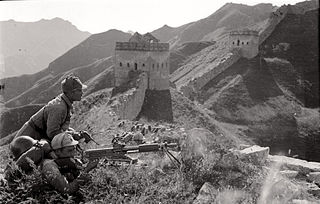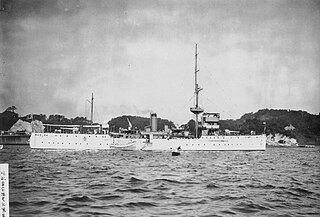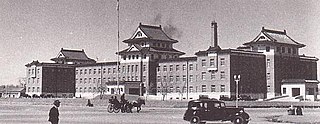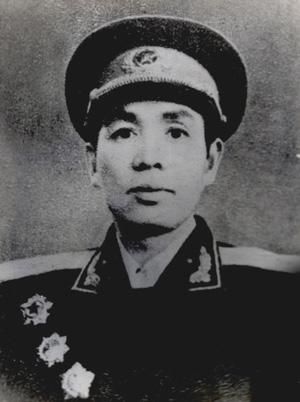
The Second Sino-Japanese War, also known as the Second China–Japan War and the Chinese War of Resistance against Japanese Aggression, was fought between the Republic of China and the Empire of Japan from 1937 to 1945 as part of World War II. It is often regarded as the beginning of World War II in Asia, although some scholars consider the European War and the Pacific War to be separate, albeit concurrent. It was the largest Asian war in the 20th century and has been described as "the Asian Holocaust", in reference to the scale of Imperial Japan's war crimes against Chinese civilians. After the Japanese attacks on Malaya and Pearl Harbor in 1941, the war merged with other conflicts which are generally categorized under the China Burma India Theater of World War II by the Western allies.

The Eighth Route Army, officially known as the 18th Group Army of the National Revolutionary Army of the Republic of China, was a group army under the command of the Chinese Communist Party, nominally within the structure of the Chinese military headed by the Chinese Nationalist Party during the Second Sino-Japanese War.
The Battle of Nanchang was a military campaign fought around Nanchang, Jiangxi between the Chinese National Revolutionary Army and the Japanese Imperial Japanese Army in the Second Sino-Japanese War. It was the first major conflict to occur following the Battle of Wuhan.

The Battle of Changde was a major engagement in the Second Sino-Japanese War in and around the Chinese city of Changde (Changteh) in the province of Hunan. During the battle, the Imperial Japanese Army extensively used chemical weapons.

The Battle of Shanggao, also called Operation Kinkō, was one of the 22 major engagements between the National Revolutionary Army and Imperial Japanese Army during the Second Sino-Japanese War.

The Battle of South Shanxi, also known as the Battle of Jinnan and Zhongtiao Mountains campaign by the Chinese and as the Chungyuan Operation by the Japanese, was one of the 22 major engagements between the National Revolutionary Army and the Imperial Japanese Army during the Second Sino-Japanese War (1937–1945).
The Battle of West Henan–North Hubei was one of the 22 major engagements between the National Revolutionary Army and Imperial Japanese Army during the Second Sino-Japanese War. It was fought in March–May 1945 in northern Hubei and western Henan. While it was a tactical stalemate, the battle was an operational victory for the Japanese forces, who seized control of local airbases, denying Chinese forces any localized air support.
The Battle of South Guangxi was one of the 22 major engagements between the National Revolutionary Army and Imperial Japanese Army during the Second Sino-Japanese War.
The Battle of South Henan, was one of the 22 major engagements between the National Revolutionary Army (NRA) and Imperial Japanese Army during the Second Sino-Japanese War. This battle was the first time the NRA engaged the Japanese in southern Henan.
The Battle of West Hubei, was one of 22 major engagements between the National Revolutionary Army and the Imperial Japanese Armed Forces during the Second Sino-Japanese War. It was also one of four major battles that took place in Hubei.
The 1939–1940 Winter Offensive was one of the major engagements between the National Revolutionary Army and Imperial Japanese Army during the Second Sino-Japanese War, in which Chinese forces launched their first major counter-offensive on multiple fronts. Although this offensive failed to achieve its original objectives, some studies have shown that it came as a heavy blow to the Japanese forces, as well as a massive shock to the Japanese military command, which did not expect the Chinese forces to be able to launch an offensive operation on such a large scale.
The Battle of Lanfeng, in the Second Sino-Japanese War, was part of the larger campaign for Northern and Eastern Henan and took place at the same time as the Battle of Xuzhou was occurring.
During the Second Sino-Japanese War the Japanese 1st Army under Lt. General Kiyoshi Katsuki drove the Chinese forces of General Cheng Qian's 1st War Area out of Northern and Eastern Honan until they were stopped by the disastrous 1938 Yellow River flood caused by the diversion of the Yellow River by the Chinese Army into the Chia-lu and Huai Rivers.

Ataka (安宅) was a river gunboat of the Imperial Japanese Navy that operated on the Yangtze River in China during the 1930s, and during the Second Sino-Japanese War.

The army groupsof the National Revolutionary Army were the largest conventional mobile formations in the organization of the army of the Republic of China during the Second Sino-Japanese War. The first army groups were established immediately after the Japanese attack at Marco Polo Bridge on 7 July 1937, and new army groups continued to be formed throughout the war.
The recorded military history of China extends from about 2200 BC to the present day. This history can be divided into the military history of China before 1912, when a revolution overthrew the imperial state, and the period of the Republic of China Army and the People's Liberation Army.

The Marco Polo Bridge incident, also known as the Lugou Bridge incident or the July 7 incident, was a battle during July 1937 in the district of Beijing between China's National Revolutionary Army and the Imperial Japanese Army.

The Kwantung Army was a general army of the Imperial Japanese Army from 1919 to 1945.

Ding Sheng was a Chinese general and politician. He served as the Governor of China's Guangdong province from 1972 until 1974.

Liu Zhijian was a People's Liberation Army lieutenant general. He was born in Pingjiang County, Hunan Province. He joined the Communist Party of China in 1931. He was a member of the Eighth Route Army during the Second Sino-Japanese War. He was captured in southern Hebei by Japanese forces, but later rescued. During the Chinese Civil War, he was active in the region of Shanxi, Hebei, Shandong and Henan Provinces. During the Cultural Revolution, he opposed Jiang Qing. He was later sent by Deng Xiaoping to Kunming for planning the Sino-Vietnamese War along with Yang Dezhi.










